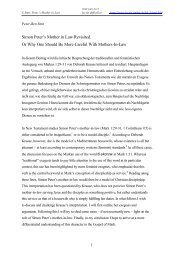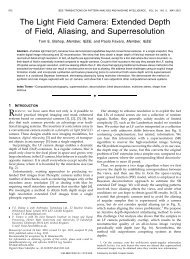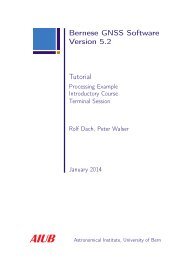Minimal Models of Adapted Neuronal Response to In Vivo–Like ...
Minimal Models of Adapted Neuronal Response to In Vivo–Like ...
Minimal Models of Adapted Neuronal Response to In Vivo–Like ...
You also want an ePaper? Increase the reach of your titles
YUMPU automatically turns print PDFs into web optimized ePapers that Google loves.
Adapting Rate <strong>Models</strong> 2119<br />
with µ ss given by equation A.8 and g E,I ≡ τ ḡ E,I /C. The adapted frequency<br />
is given by the solution <strong>of</strong> either f = CB (m 0 − αf, s 0 ) (AHP-based model)<br />
or f = CB (θ 0 + βf ; m 0 , s 0 ) (adapting threshold model).<br />
Appendix B: Fitting Procedure<br />
Here we briefly summarize the experimental procedure and the data analysis<br />
that led <strong>to</strong> the results <strong>of</strong> Table 1. Full details can be found in Rauch et<br />
al. (2003). Pyramidal neurons from layer 5 <strong>of</strong> rat soma<strong>to</strong>sensory cortex were<br />
injected with an OU process with a correlation time constant τ ′ = 1ms<strong>to</strong><br />
resemble white noise. Stimuli were delivered in random order from a preselected<br />
pool, which depended on the cell. The time length <strong>of</strong> the stimulus<br />
was between 6 and 12 seconds. The spike trains <strong>of</strong> 26 selected cells were analyzed<br />
<strong>to</strong> assess their mean spike frequencies. A transient ranging from 0.5 <strong>to</strong><br />
2 seconds (depending on stimulus duration) was discarded <strong>to</strong> deal with the<br />
stationary spike train only. On balance, the stationary response was usually<br />
adapted with respect <strong>to</strong> the transient one. The model rate functions were<br />
fitted <strong>to</strong> the experimental ones using a random least-square procedure, that<br />
is, a Monte Carlo minimization <strong>of</strong> the function (see, e.g., Press, Teukolsky,<br />
Vetterling, & Flannery, 1992),<br />
χ 2 N−M = N∑<br />
i=1<br />
[<br />
MODEL (m i , s i ; ) − f i<br />
i<br />
] 2<br />
,<br />
where i runs over the experimental points, f i are the experimental spike<br />
frequencies, is the parameter set, and the weights i correspond approximately<br />
<strong>to</strong> a confidence interval <strong>of</strong> 68% for the output rate. M is the number<br />
<strong>of</strong> parameters <strong>to</strong> be tuned and N the number <strong>of</strong> experimental points. The<br />
best-fit was accepted if the probability <strong>of</strong> a variable χN−M 2 <strong>to</strong> be larger than<br />
the observed χmin 2 was larger than 0.01. The parameter set includes five parameters:<br />
τ r , V r , C, τ, and α [pA·s] for the AHP adaptation or β [mV·s] for<br />
the adapting threshold mechanism. Note that since LIF , equation 2.3, is<br />
invariant under the scaling θ → θh, V r → V r h, C → C/h (h constant), only<br />
two out <strong>of</strong> these three parameters are independent. Therefore, the threshold<br />
for spike emission (θ 0 in the case <strong>of</strong> an adapting threshold) was set <strong>to</strong> 20 mV<br />
throughout. The results are summarized in Table 1 and discussed in the text.<br />
Appendix C: The Effects <strong>of</strong> Adaptation on the LIF Neuron<br />
Here we summarize and compare the properties <strong>of</strong> the LIF neuron endowed<br />
with the two models <strong>of</strong> adaptation, which are mentioned in the analysis <strong>of</strong><br />
the experimental data in section 2.3. We will refer <strong>to</strong> the self-consistent solutions<br />
<strong>of</strong> equation 2.2 and 2.8 as f α (m, s), f β (m, s), respectively. We consider<br />
the regions <strong>of</strong> low and intermediate-<strong>to</strong>-large rates in turn.
















